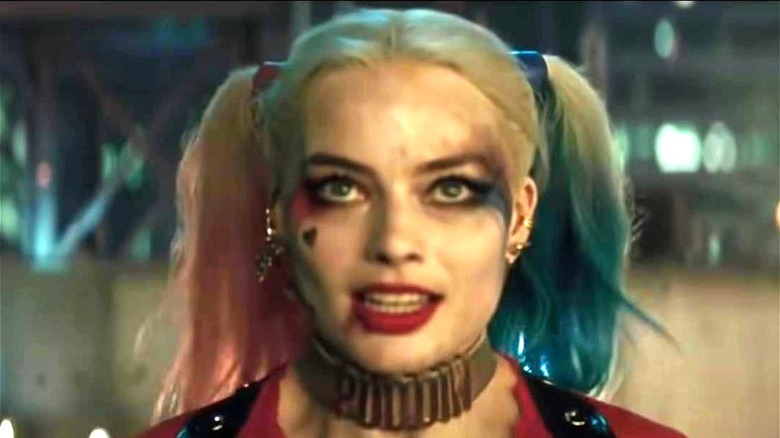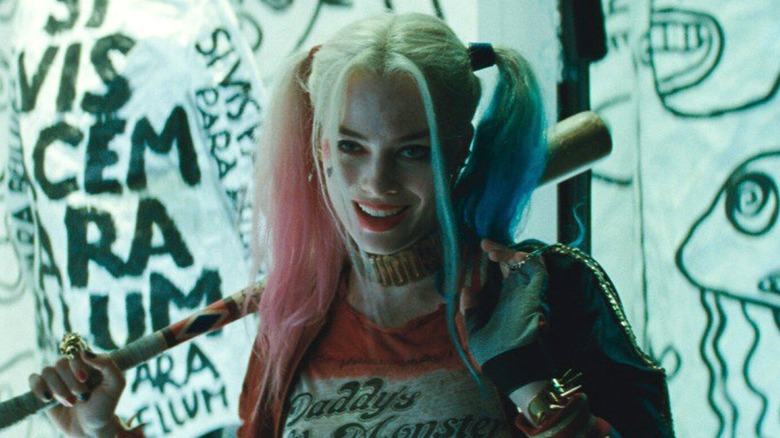Why Harley Quinn's Suicide Squad Costume Makes No Sense
Harley Quinn has become one of DC's most recognizable characters. Following her first appearance in "Batman: The Animated Series," she went on to join the comics, and finally made her cinematic debut in 2016's "Suicide Squad" where she was played by Margot Robbie, who still holds the role to this day.
In that film, Harley is joined by a group of fellow villains, including Deadshot (Will Smith) and El Diablo (Jay Hernandez), whom have been assembled together by U.S. intelligence officer Amanda Waller (Viola Davis). Waller gathers the strange and villainous group because she needs help fighting the Enchantress (Cara Delevingne) — who poses a threat to the world — and signs the felons up on the agreement that they will have their prison sentences reduced if they agree to help. Harley agrees to the mission largely under the delusional presumption her beloved Joker will eventually spring her loose from Waller's clutches (which he does, at the film's end), but she actually ends up being a key player in defeating the Enchantress.
Harley Quinn was not the only iconic DC character to appear on the silver screen for the first time in "Suicide Squad," and the film made many divisive decisions when it came to adapting its many bad guys. These adaptational challenges included the costumes that the actors wore: after all, attempting to stay accurate to the source material, but also create a fresh and exciting look, can be a difficult balance.
Harley's costume was arguably the most controversial outfit, though. On one hand, it was 2016's most Googled Halloween costume (per Vogue), but on the other hand, the outfit garnered a great deal of criticism, even from Robbie herself (per Cinema Blend). Critiques aside, Harley's costume does raise a few eyebrows in regard to practicality.
A jacket, shirt, and shorts combo is not ideal for fighting
In "Suicide Squad," Harley wears a red and blue jacket featuring white and yellow detailing, a white and red baseball tee that reads "Daddy's Lil Monster," and a pair of sequined red and blue shorts. The ensemble is topped off with a matching studded belt, a bat for combat, and pink and blue dyed pigtails. This is a pretty big change from her classic, jester-inspired black and red bodysuit in the comics.
The biggest issue with the outfit, aesthetics aside, is that it makes no sense as something to be fighting in, whether against the Enchantress, Batman, or other criminals. Furthermore, it's very telling that Harley's other squad members are fully clothed, with almost no skin showing, and are equipped with more protective layers than her. For example, Deadshot has a full red and black bodysuit with body armor. In contrast, Harley's costume is incredible revealing, and protects her from essentially nothing. While there are non-armored male characters, like Killer Croc and El Diablo, they have superpowers — which Harley does not.
When Harley returns in "Birds of Prey (and the Fantabulous Emancipation of One Harley Quinn)" she again wears a shirt and shorts for most of the movie, but they cover much more of her body, exposing her to less damage. Furthermore, in 2021's "The Suicide Squad," Harley finally is seen wearing something much more accurate to the comics, and more suitable for combat — sporting red and black pants, a jacket, and a bustier, featuring her signature diamond print. Most importantly, though, her post-"Suicide Squad" outfits, while hardly body armor, have at least made sense.

